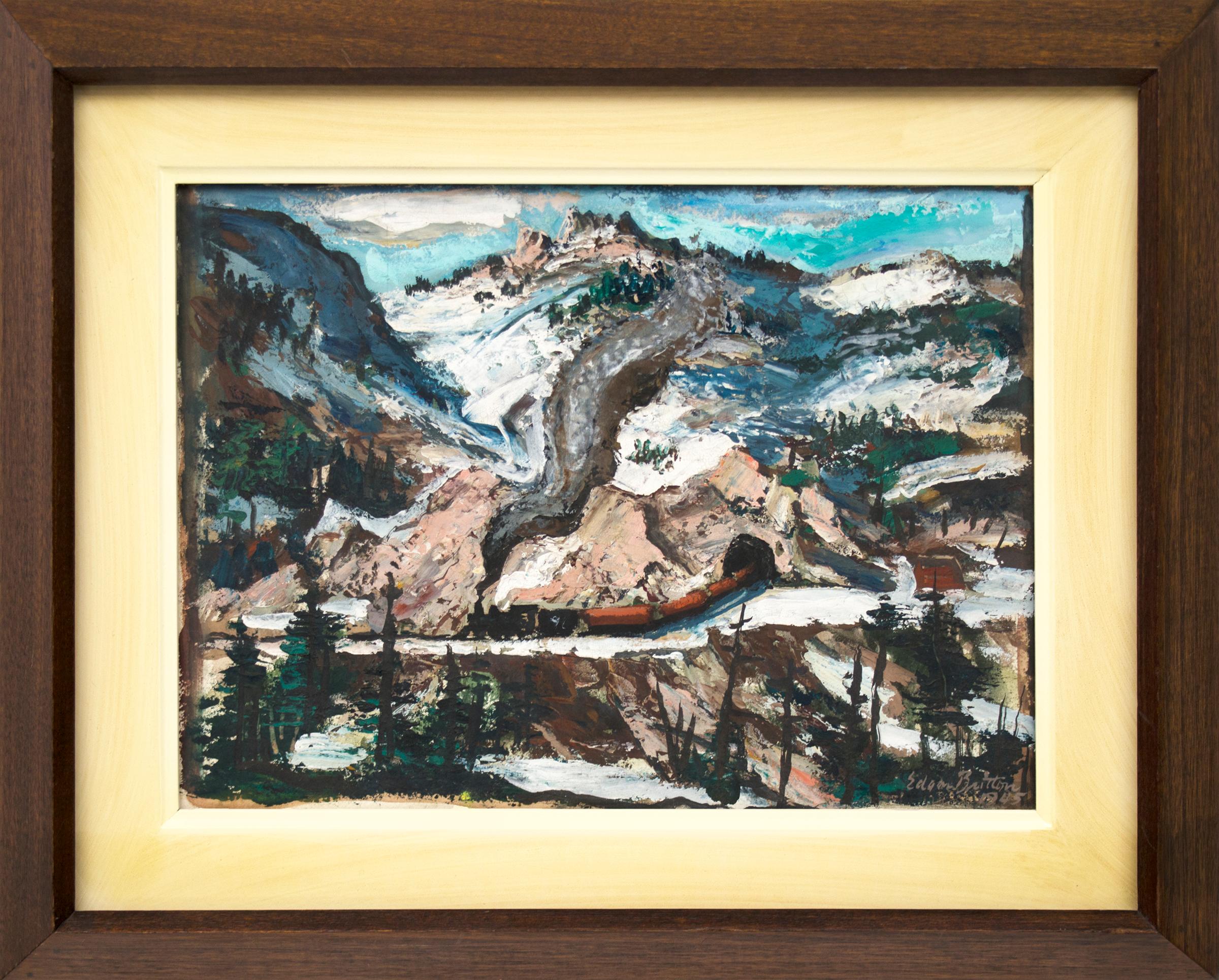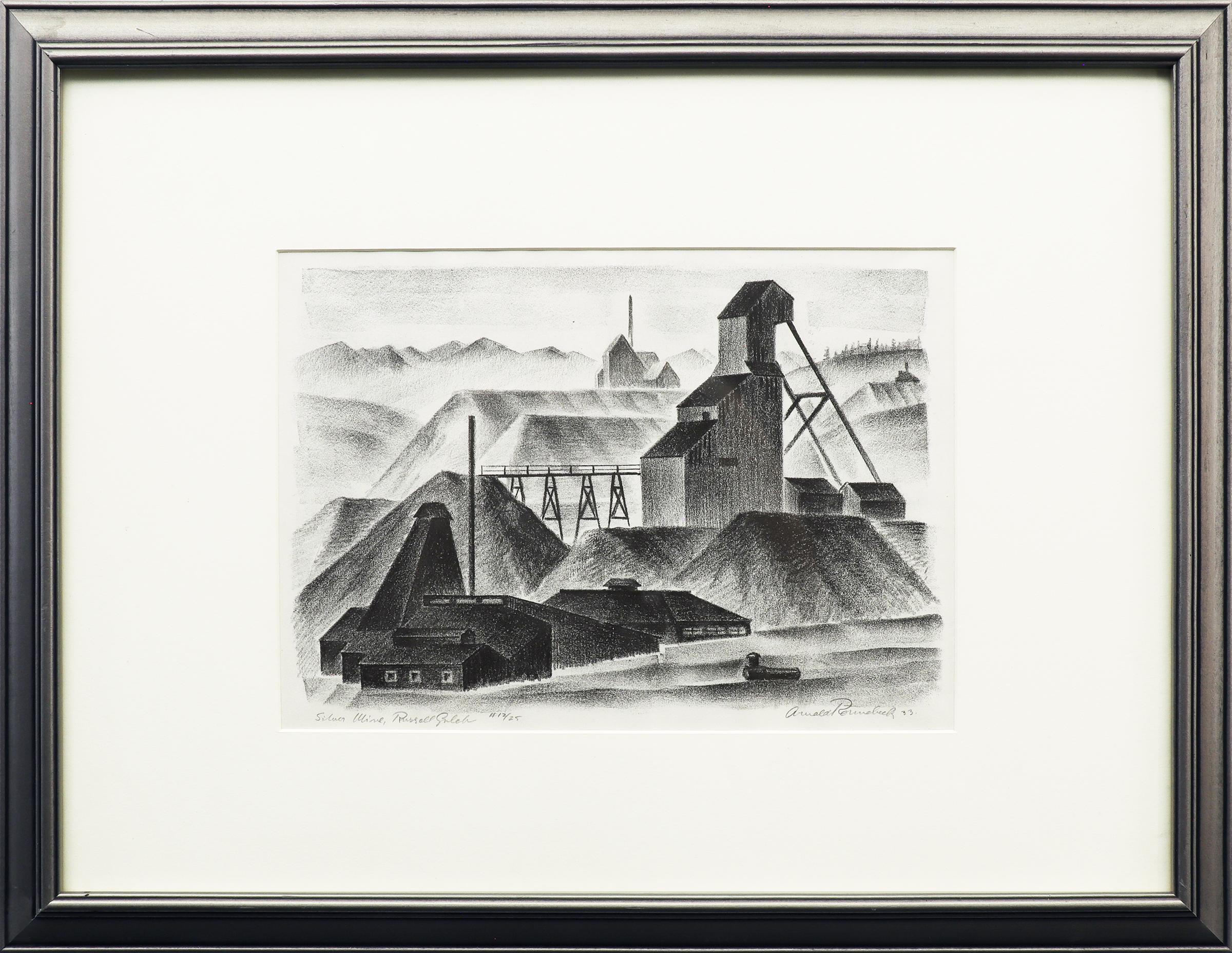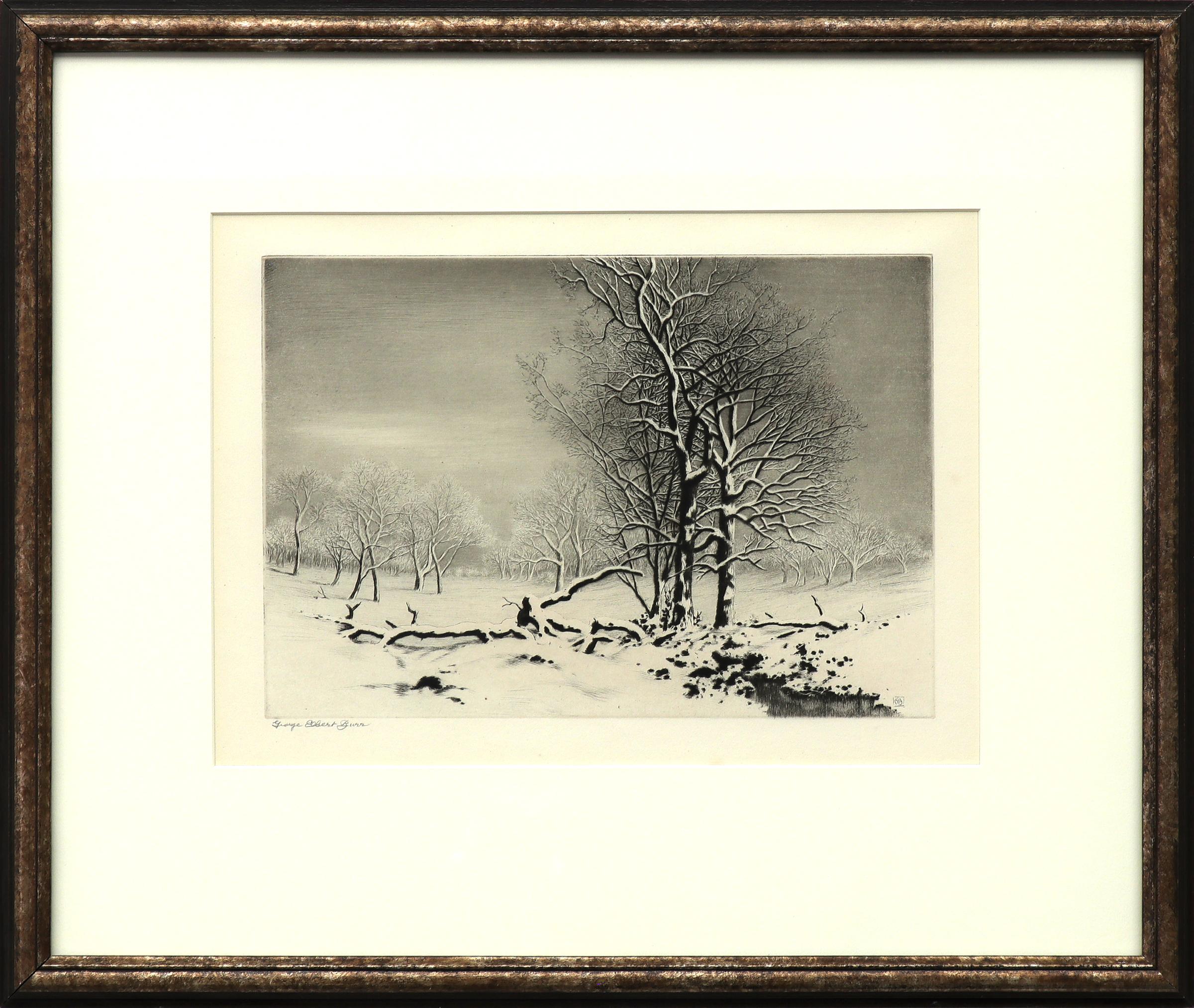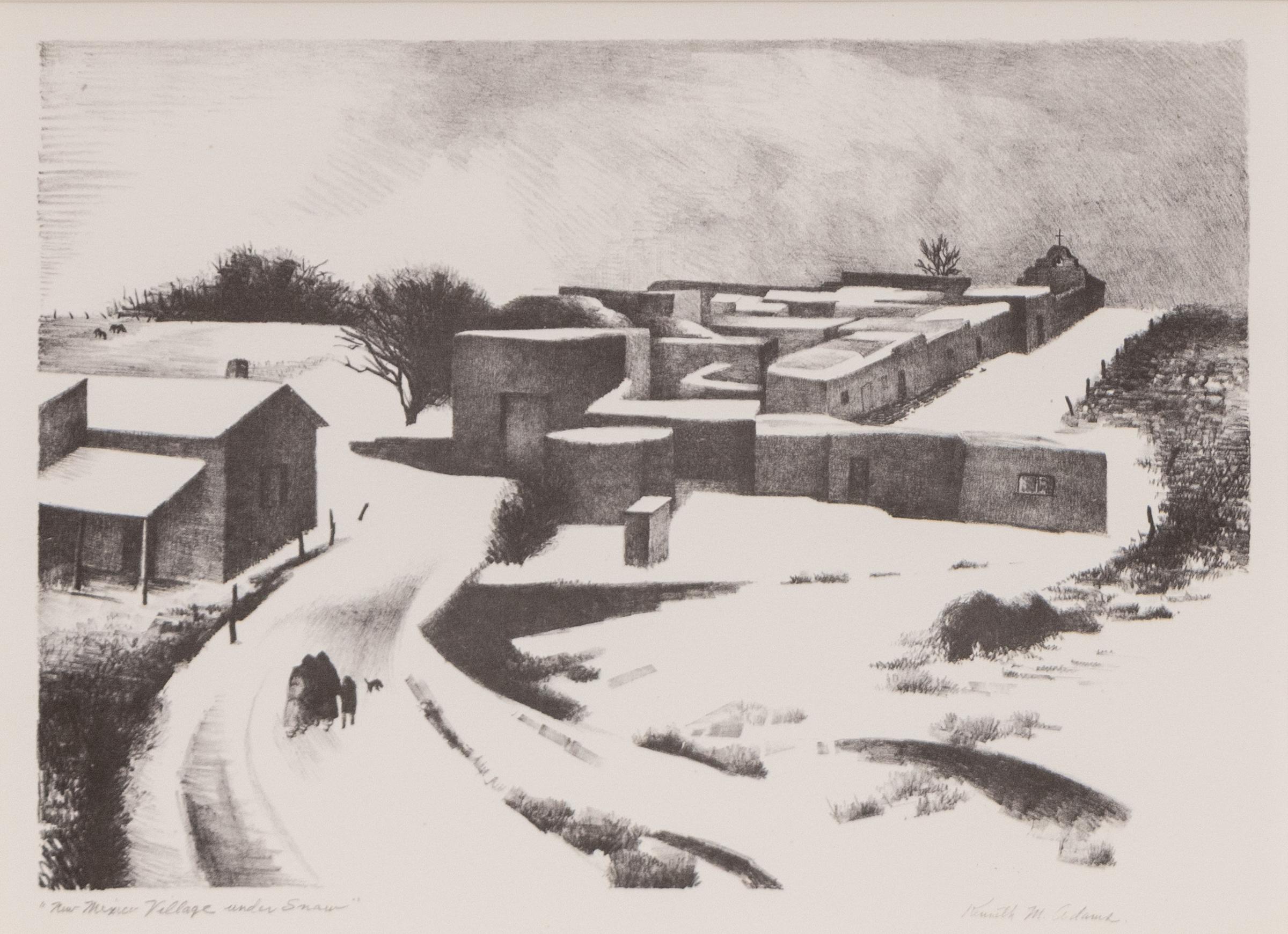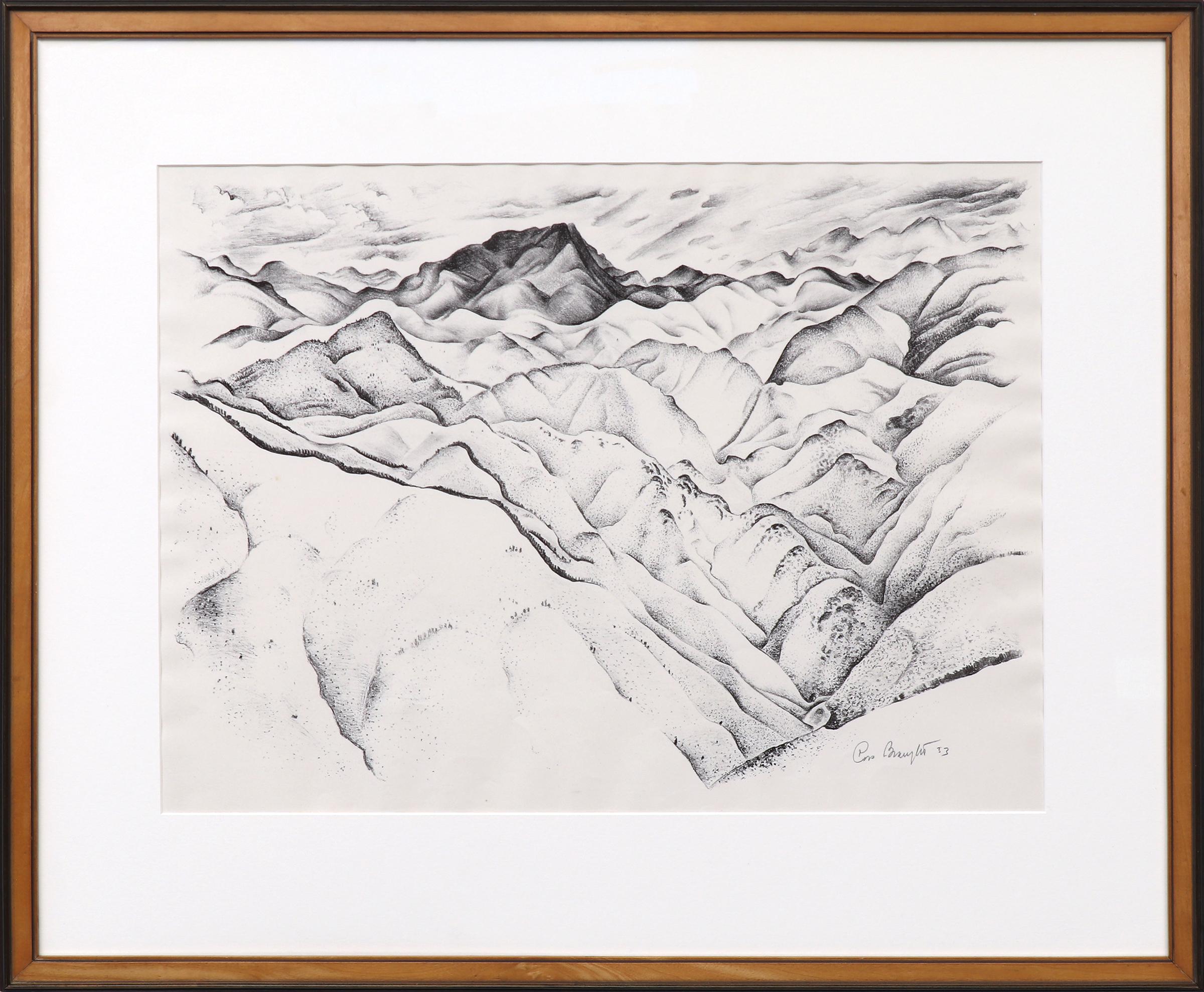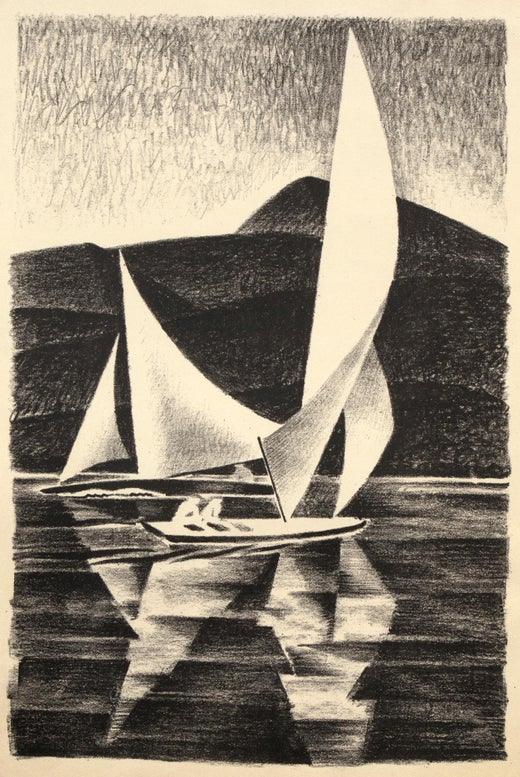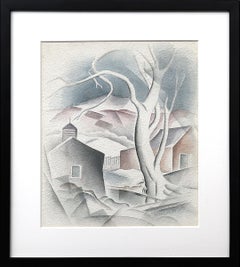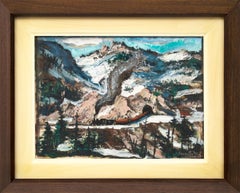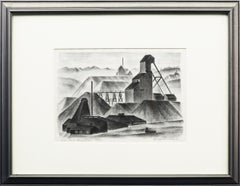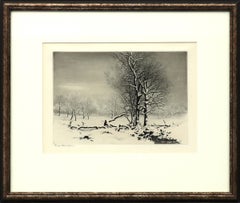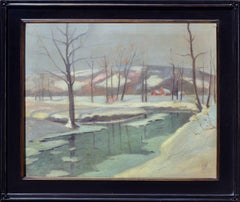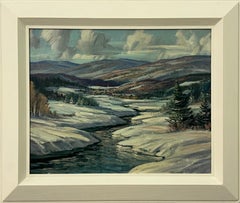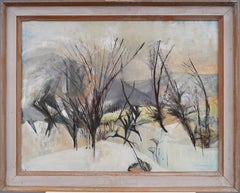Items Similar to Mine Near Continental Divide – 1930s Winter Landscape of Colorado Mountains
Want more images or videos?
Request additional images or videos from the seller
1 of 17
Arnold RönnebeckMine Near Continental Divide – 1930s Winter Landscape of Colorado Mountains1933
1933
$2,280
$2,85020% Off
£1,713.96
£2,142.4520% Off
€1,987.02
€2,483.7820% Off
CA$3,183.23
CA$3,979.0420% Off
A$3,565.39
A$4,456.7420% Off
CHF 1,855.19
CHF 2,318.9920% Off
MX$43,301.43
MX$54,126.7820% Off
NOK 23,519.12
NOK 29,398.9020% Off
SEK 22,192.04
SEK 27,740.0520% Off
DKK 14,826
DKK 18,532.5020% Off
Shipping
Retrieving quote...The 1stDibs Promise:
Authenticity Guarantee,
Money-Back Guarantee,
24-Hour Cancellation
About the Item
This rare 1933 lithograph by renowned modernist artist Arnold Rönnebeck captures a dramatic black-and-white winter scene of a Colorado mountain mine, blanketed in snow. The bold contrasts and fine detail reflect Rönnebeck’s signature Precisionist style, making this an exceptional piece of historic Colorado art.
This lithograph is signed and comes directly from the estate of Arnold Rönnebeck. It is presented in a custom frame measuring 18 ¼ x 22 ¼ inches, with an image size of 10 ¼ x 14 ½ inches.
About the Artist – Arnold Rönnebeck (1885-1947)
A pioneering modernist sculptor, lithographer, and museum administrator, Arnold Rönnebeck was a key figure in both European and American avant-garde art circles. Originally from Germany, he studied under Aristide Maillol and Émile-Antoine Bourdelle in Paris and later moved to Denver, Colorado, in 1926.
Rönnebeck’s lithographs, known as "living cubism," depict urban landscapes, industrial scenes, and the rugged beauty of the Rocky Mountains and mining towns. His work has been exhibited in major institutions, including the Weyhe Gallery in New York (1925), the Denver Art Museum (1947), the Albuquerque Museum (1991), and the Arizona State University Art Museum (1992). His pieces are also part of permanent collections at the Denver Art Museum, Smithsonian American Art Museum, Brooklyn Museum, Art Institute of Chicago, and Colorado Springs Fine Arts Center.
This historically significant lithograph is an outstanding addition for collectors of Western art, Colorado history, and American Precisionism.
- Creator:Arnold Rönnebeck (1885 - 1947)
- Creation Year:1933
- Dimensions:Height: 18.25 in (46.36 cm)Width: 22.25 in (56.52 cm)Depth: 0.75 in (1.91 cm)
- Medium:
- Movement & Style:
- Period:
- Framing:Frame IncludedFraming Options Available
- Condition:very good condition.
- Gallery Location:Denver, CO
- Reference Number:Seller: 263421stDibs: LU27310640482
Arnold Rönnebeck
Modernist sculptor, lithographer and museum administrator, Rönnebeck was a noted member of European and American avant-garde circles in the early twentieth century before settling in Denver, Colorado, in 1926. After studying architecture at the Royal Art School in Berlin for two years beginning in 1905, he moved to Paris in 1908 to study sculpture with Aristide Maillol and Émile-Antoine Bourdelle. While there he met and befriended American modernist painter, Marsden Hartley, of whom he sculpted a bronze head that was exhibited at the Salon d’Automne in Paris in 1912 and the following year at Hartley’s solo show of paintings at Alfred Stieglitz’s Gallery 291 in New York. After World War I Rönnebeck traveled in Italy with German writer, Max Sidow, and German poet, Theodor Daubler, doing a series of drawings of Positano and the Amalfi Coast that formed the basis for his lithographs on the subject. The death of his finacée, the young American opera singer Alice Miriam in 1922 and his own family’s increasing financial problems in post-World War I Germany led him to immigrate to the United States in 1923. After living briefly with Miriam’s family in Washington, DC, he moved to New York where he became part of the avant-garde circle around Alfred Stieglitz. In the summer of 1925, as the guest of Mabel Dodge Luhan, Rönnebeck first saw Taos, New Mexico, which Marsden Hartley had encouraged him to visit. It was there that he met his future wife, Louise Emerson, an easel painter and muralist. A year later they were married in New York before relocating to Denver. He served as director of the Denver Art Museum from 1926 to 1930 where he invited Marsden Hartley to lecture on Cézanne’s art in 1928. Rönnebeck fostered the development of the museum’s collection of American Indian art and the curation of modernist art exhibitions. In addition to his work at the museum, he was professor of sculpture at the University of Denver’s College of Fine and Applied Arts from 1929 to 1935, and wrote a weekly art column in the Rocky Mountain News. In Colorado, the subject matter of his lithographs became the state’s landscape and its mining towns, as well as Native Americans from the pueblos in neighboring New Mexico. By the early 1930s Colorado’s old mining towns became a popular genre for artists because they were easily accessible, and their architectural components provided a welcome break from the nineteenth-century panoramic landscape tradition and the overwrought cowboy-and-Indian subject matter of the previous generation. As an amateur actor and music enthusiast, Rönnebeck had an additional connection with Central City. In June 1947, some five months before his death, the Denver Art Museum organized a solo exhibition of his sculptures, watercolors and prints. © copyright Stan Cuba for David Cook Galleries
About the Seller
5.0
Gold Seller
Premium sellers maintaining a 4.3+ rating and 24-hour response times
Established in 1979
1stDibs seller since 2013
289 sales on 1stDibs
Typical response time: 13 hours
- ShippingRetrieving quote...Shipping from: Denver, CO
- Return Policy
Authenticity Guarantee
In the unlikely event there’s an issue with an item’s authenticity, contact us within 1 year for a full refund. DetailsMoney-Back Guarantee
If your item is not as described, is damaged in transit, or does not arrive, contact us within 7 days for a full refund. Details24-Hour Cancellation
You have a 24-hour grace period in which to reconsider your purchase, with no questions asked.Vetted Professional Sellers
Our world-class sellers must adhere to strict standards for service and quality, maintaining the integrity of our listings.Price-Match Guarantee
If you find that a seller listed the same item for a lower price elsewhere, we’ll match it.Trusted Global Delivery
Our best-in-class carrier network provides specialized shipping options worldwide, including custom delivery.More From This Seller
View All1930s American Modernist Colorado Winter Landscape Watercolor, Trees, Mountains
Located in Denver, CO
This 1938 watercolor painting by American Modernist artist Turner B. Messick depicts a serene winter landscape, likely set in Colorado. The scene features a bare tree in the foregrou...
Category
1930s American Modern Landscape Paintings
Materials
Watercolor
1940s Winter Colorado Mountain Landscape Gouache Painting with Snow and Train
Located in Denver, CO
This stunning 1945 winter landscape painting by American artist Edgar Britton (1901-1982) captures the beauty of a snow-covered mountain scene with a tree-lined road, likely in Color...
Category
1940s American Modern Landscape Paintings
Materials
Gouache, Archival Paper
Silver Mine, Russell Gulch, CO (12/25) 1930s American Modern Lithograph Print
By Arnold Rönnebeck
Located in Denver, CO
"Silver Mine, Russell Gulch (12/25)" is a captivating black and white lithograph by American artist Arnold Ronnebeck. The piece features a mining scene in Russell Gulch, Colorado, wi...
Category
1930s American Modern Figurative Prints
Materials
Lithograph
Original Signed 1920s Lithograph Print of Winter Landscape with Snow and Trees
By George Elbert Burr
Located in Denver, CO
This original signed lithograph print by George Elbert Burr (1859-1939) features a serene winter landscape with snow-covered trees, capturing the tranquil beauty of nature in a crisp winter scene. Known for his etchings and prints, Burr’s lithograph technique beautifully reflects his mastery in portraying the delicate interplay of light, snow, and shadows in the landscape. The print is signed by the artist and is presented in a custom frame with archival materials for long-lasting preservation. The framed dimensions measure 15 x 17 ¾ inches, with the image size itself being 7 ¼ x 10 ¼ inches.
About the Artist:
George Elbert Burr was a prolific American artist born in Monroe Falls, Ohio, in 1859. From an early age, Burr showed a passion for art, creating his first etchings using zinc scraps found in his father’s hardware store. Despite limited formal training—attending the Art Institute of Chicago for only a short period—Burr developed a unique and impactful style, focusing on etchings, lithographs, and illustrations. His early works often reflected the rural landscapes of Missouri, which he sketched during his travels on a railway pass.
Burr gained recognition as an illustrator, working with notable publications like Scribner’s, Harper’s, and The Observer. In 1892, he began a monumental project illustrating the Metropolitan Museum of Art’s catalog of Heber R. Bishop’s jade collection, completing approximately 1,000 etchings.
From 1896 to 1901, Burr and his wife traveled extensively across Europe, capturing landscapes and scenes from Sicily to North Wales. In 1906, Burr moved to Denver, Colorado, where he created the Mountain Moods series and began to document the American Southwest. His work often featured the rugged beauty of the Arizona desert and the New Mexico landscape. Burr’s Desert Set...
Category
20th Century American Modern Landscape Prints
Materials
Lithograph
1950s Signed New Mexico Winter Lithograph – Original Vintage Snowy Landscape Art
By Kenneth Miller Adams
Located in Denver, CO
Step into the serene beauty of a New Mexico winter with this stunning 1950s signed lithograph, New Mexico Village Under Snow, by acclaimed artist Kenneth Miller Adams. This rare vint...
Category
1950s American Modern Landscape Prints
Materials
Lithograph
1933 American Art Lithograph, Clear Creek Canyon by Ross Braught, Colorado
By Ross Eugene Braught
Located in Denver, CO
This striking original lithograph, Clear Creek Canyon I (Colorado), was created in 1933 by acclaimed American artist Ross Eugene Braught (1898–1983). A master of landscape and form, ...
Category
1930s American Modern Landscape Prints
Materials
Lithograph
You May Also Like
A Winter Scene - Snowy 1930's Landscape
By Frederick R. Wagner
Located in Soquel, CA
Serene winter landscape of a snow covered hills with a frozen creek and far off house in the distance by Frederick Wagner (American, 1864-1940), c.1930's. Signed "F. W." lower right....
Category
1930s American Impressionist Landscape Paintings
Materials
Canvas, Oil
$5,200 Sale Price
20% Off
Vintage Winter Snowy River Mountain Landscape of Canada by 20th Century Artist
Located in Preston, GB
Vintage Winter Snowy Mountain River Landscape Oil Painting of La Rivière du Nord in Canada, by 20th Century Canadian Artist, Sydney Berne (1921-2013)
Ar...
Category
1970s American Modern Landscape Paintings
Materials
Canvas, Oil
Landscape with Farm House in Winter
By Charles Frederick Surendorf
Located in San Francisco, CA
This artwork "Landscape with Farm House in Winter" c.1950, is a oil painting on hardboard by noted California artist Charles Frederick Surendorf, 1906-1979. It is signed at the lower...
Category
Mid-20th Century American Impressionist Landscape Paintings
Materials
Oil
Signed Vintage American School Modernist Winter Cubist Framed Landscape Painting
Located in Buffalo, NY
Finely painted bright and brilliant cubist winter landscape. Framed nicely and signed lower right. Excellent mid century example.
Category
1960s Cubist Abstract Paintings
Materials
Canvas, Oil
$1,020 Sale Price
20% Off
"Winter Moutain Scene" by Carl Lawless
Located in West Chester, PA
A very nice oil on canvas in its original frame showing a small snowy village nestled in the mountains.
Category
Early 20th Century American Paintings
Winter Landscape 1938
Located in Missouri, MO
Monogrammed Lower Right and Dated 1938
This is by the stage designer, Walter Kubbernuus, for the opera Katyusha by Franco Alfano. After Tolstoi.
Monogrammed Lower Right.
Category
Early 20th Century Landscape Drawings and Watercolors
Materials
Gouache
More Ways To Browse
Royal Yacht Britannia
David Tomb
Tiffany Studios American Indian
Touchstone Publishers
Vintage United Airlines Travel Posters
Arnold Bocklin
Western Airlines Poster
Albion Press
Vintage Mardi Gras
Voyage Skirts
Concorde Drawing
Dior Tie Clip
Fanny Brennan
Huchet Lithograph
Mulberry Tree
Urbain Huchet Lithograph
Altman Etchings
Arthur Bourgeois

